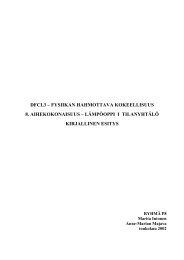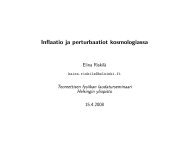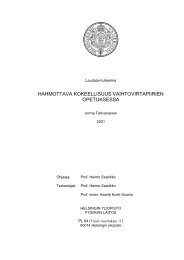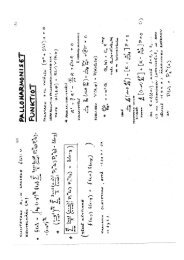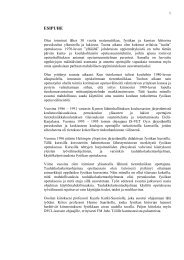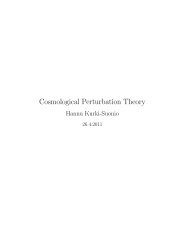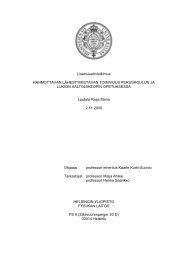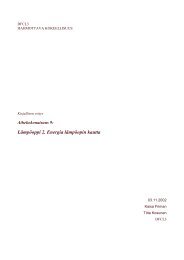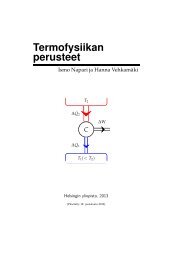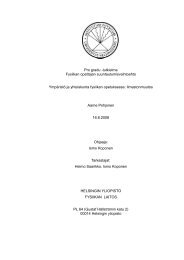Wave propagation Motivation for us
Wave propagation Motivation for us
Wave propagation Motivation for us
You also want an ePaper? Increase the reach of your titles
YUMPU automatically turns print PDFs into web optimized ePapers that Google loves.
<strong>Wave</strong> <strong>propagation</strong>• <strong>Wave</strong>s are important in space research– remote observations from radio waves to gamma rays• the signals propagate through space plasma– wave diagnostics of medium• ionospheric radars, Faraday rotation, etc.• <strong>Wave</strong>s in space plasmas– wide variety of wave modes– natural response of plasma to perturbations– specific frequencies• plasma frequency, gyro frequency and their hybrids– energy transfer• particle acceleration / heating• instabilities<strong>Motivation</strong> <strong>for</strong> <strong>us</strong>1
In absence of charges and currentsMaxwell’s equations reduce toEM waves in vacuumhomogeneo<strong>us</strong> wave equations<strong>propagation</strong> speed:Consider <strong>propagation</strong> to ±z – direction and plane wave solutions.For a plane wave there is a plane propagating with the wave wherethe electric field is constant. Such a solution can be written asor in vector <strong>for</strong>mamplitudeangular frequencywave numberphase speedA wave can be considered as a plane wave only far from the source.Sometimes it is necessary to consider spherical waves, i.e., waves,<strong>for</strong> which there exists a spherical surface where E is constant.An example is the field of a radiating dipole:(this is an approximation up to terms of the order of 1/r 3 ; the exactsolution can be expressed in terms of Bessel functions)Plane waves are most convenientto treat <strong>us</strong>ing the complex notationNow the differential operationsreduce to multiplicationsand Maxwell’s equationsbecome algebraic equations2
From vacuum to dielectric mediaIf there are no free charges or currents, but 0 and 0 (but constants)Nowis the index of refractiondispersion equationphase velocity (<strong>propagation</strong> of the constant phase)group velocity (<strong>propagation</strong> of energy and in<strong>for</strong>mation!)If in addition J = E ( constant), the situation is more complicatedone <strong>for</strong>m of so-called telegrapher’s equations;a standard class-room example of <strong>us</strong>ing Fouriertrans<strong>for</strong>mations to solve partial differential equationsInstead of making the Fourier trans<strong>for</strong>mations, let’s start from Maxwell’sequations and make the plane wave assumptionClearly k, E and H are all perpendicularto each other: transversal waveChoose: k || e z , E || e x , H || e ydispersion equationnow !writeThe solution isselect the phase of sothat the wave is damped!impedance of the medium:skin depth3
Examples<strong>Wave</strong> polarizationConsider an EM wave propagating in +z directionFoc<strong>us</strong> on the plane z = 0, denote = E y /E x = – H x /H y ;1) If is real, E y and E x are in the same phaseDirection of E is (1,,0) (if = , E is in the y-direction)This is a linearly polarized wave2) If = +i, there is a phase shift (= /2) between E y and E xThis is a right-hand circularly polarized wave (positive helicity)3) If = –i , there is a phase shift ( = –/2) between E y and E xThis is a left-hand circularly polarized wave (negative helicity)4) If is a general complex number, the wave is elliptically polarizedAll polarizations can be obtained from left- and right-hand polarizedwaves by superposition.WARNING: In optics the left- and right-hand polarizations are definedin the opposite way!!4
k is a vector<strong>Wave</strong> vector:unit vector defining thedirection of the wave normal surface of constant wave phase;it is the direction of wave <strong>propagation</strong>In isotropic media k ||If the medium is anistropic, it is possible thati.e., the energy does not need to propagate in the direction of wave normal.Energy and infromationpropagate with the group velocityLetbe the angle between B and k and the frequency a function of k andangle between v g and v pReflection and refractiontransmitted,refractedincidentreflectedThis is vertical polarization (E has a vertical component)The opposite case is horizontal polarizationAll polarizations can be expressed as superposition of these.5
Boundary conditions:Surface currentinduced by the waveAssume K = 0 These conditions m<strong>us</strong>t be filled all the time at every point on the interface As the incident and reflected waves are in the same medium, we get theresults familiar from the high-school physicsSnell’s law6
Reflection coefficient <strong>for</strong> vertical polarizationIn our examplesFresnel’s <strong>for</strong>mulas<strong>for</strong> vertical polarizationtransmission coefficient <strong>for</strong> vertical polarizationFresnel’s <strong>for</strong>mulas<strong>for</strong> horizontal polarizationExample: Total reflection from the ionosphereFor radio waves of sufficiently high frequencyThe air below the ionosphere is a good non-conductive dielectricIn the ionosphereFresnel’s <strong>for</strong>mulas <strong>for</strong> all angles of incidenceTh<strong>us</strong> the horizontal polarization is more efficient in radio communicationsvia the ionosphere than the vertical polarizationFor sufficiently largei.e., the whole wave is reflected;total reflection7
Dispersion of the medium(so-called Drude-Lorentz model)In dispersive media (in plasmas we can <strong>us</strong>ually assume )Consider the motion of an electron boundto an atom by a harmonic <strong>for</strong>ceelectronInclude a frictional <strong>for</strong>ce to dampthe harmonic oscillationsatomUnder the influence of an external electric field the eq. of motion becomesLet the time dependences be harmonicBy definition the dipole moment associated with this electron isAssume that in a unit volume there are N molecules and Z electrons/moleculeLetelectrons of each molecule have an eigenfrequencyand a damping factor”oscillation strengths”:Þ the density of dipole moments, i.e., electric polarization / unit volumeWrite the electric displacementThe electric permittivity is a complex function and depends on the frequency8
Let the number of free electrons / molecule beTheir eigenfrequencies areAmpère’s law:conductanceelectronsStatic conductivity is a goodapproximation <strong>for</strong> Cu, ifcompare with FM radioare resonant frequenciesOften almost real, except whenDispersion is calledonly close to resonant frequencies, whereAt resonance energy is transferred between the wave and particlesPolarization current isand the work done by E is9
Averaging over one oscillation periodNote that this model always hasand th<strong>us</strong> cannot be applied to lasers or plasmainstabilities where the wave gains energy from plasmaenergy transferfrom field to particlesrefractive index:wave number:phase velocity:group velocity:Radio wave <strong>propagation</strong> in the ionosphere10
Isotropic, lossless ionosphereIsotropic: No effects of B included; OK ifLossless: Effects of collisions neglected; OK ifThese are fulfilled ifConsider the electron motion in the electric field of a (plane) waveassuming that ions <strong>for</strong>m an immobile background.Now we determine and Th<strong>us</strong> we have <strong>for</strong>mally found Ohm’s law withAssume that except <strong>for</strong> this conductivity the plasma is vacuum:Now the Ampère-Maxwell lawyields <strong>for</strong> the plane wavesTh<strong>us</strong> the medium looks like dielectric withIn plasma physics we often writeThe index of refraction isandxEkzBykIf X > 1, the wave does not propagate11
In the ionosphere the maximum electron densities are of the order the maximum plasma frequency in the ionosphere is about 9 MHzEM wave packet (f < 9 MHz) propagates vertically up and returns after time TVirtual reflection height:real reflection height v g becomes zeroIn realityIonosondeLinear density profileReal reflection takes place wherefrom which we get the virtual heightParabolic density profile is also straight<strong>for</strong>ward to calculate (exercise) fromm refers to maximum density12
Oblique <strong>propagation</strong>: angle between the vertical direction and kThe horizontal distance of wave packet <strong>propagation</strong>The vertical motion is obtained by substitutionthe real height at time tEliminating t:This gives the ”ray path”.In isotropic plasma the ray propagates in the direction of nWeakly inhomogeneo<strong>us</strong> ionosphere(the WKB approximation)What happens at the reflection point, i.e., wherethe vertical component of the group velocity is zero?Reflection is expected to take place at each interface of different nConsider a wave with and (<strong>for</strong> simplicity) vertical <strong>propagation</strong>Þreflection should be easy to observebut there is no reflection!!Construct a model ionosphere consisting ofof thin layers with upward increasing density, i.e.,decreasing index of refractionFigure is <strong>for</strong> oblique<strong>propagation</strong> but letAt each layerbut this is not the whole story.The phase of the wave ateach layer becomes critical13
Let E 0 be the amplitude <strong>for</strong> the incident wave in the neutral atmosphereThe electric field of the wave after reflection isFrom each layeris reflectedis refracted the electric field of the refracted wave grows!The wave propagates toward an increasing impedanceFor the wave magnetic fieldAt the limit of continuo<strong>us</strong> profileAt each layer the phase of the wave is shifted byAt the altitude z the accumulated retardation is given byThis is the WKB approximation(Wentzel, Kramers, Brillouin)The electric and magnetic fields are nowNow the Poynting vector is constant:This implies that no net energy is carried by the partially reflected wavesdue to the interference of different phases of waves reflected at differentlayers. This requires that the profile is smooth enough as compared tothe wavength of the wave. Let’s try to quantify this.Amplitude of each partial wave isand the phase differencebetween waves reflected from two consecutive layersConstruct a phase amplitude diagram witharc element representingeach partial waveassociated phase14
Add arc elements to each other by turningthe next one with respect to the previo<strong>us</strong>one by the phase angleMove to the continuo<strong>us</strong> limitrdIf no reflection would take place, this wouldgive a circle. In case of reflection the radi<strong>us</strong>increases resulting in a spiralThe increase of the radi<strong>us</strong> can be neglected ifTh<strong>us</strong> the WKB approximation breaks if• k 0 is small (long wave wrt. the gradient scale length• n 0 (close to the actual reflection point)• at local gradients with otherwise smooth profileAbove the reflection region n 2 < 0 and th<strong>us</strong> n is imaginaryAt the reflection pointthe wave is dampedthe WKB approximation breaksThe field can, can however, be calculated analytically if the profileclose to the reflection point is linear.Now Maxwell’s equations can be written asassuming linear profilechange of variable 15
is known as Airy’s differential equationwhose solutions areAiry integralsBiAiAs the wave m<strong>us</strong>t vanish abovethe reflection point, C 2 = 0The amplitude and period increase–whenThereafter the field approachesrapidly 0Ai can be given in the integral <strong>for</strong>mTo determine the constant C 1 the Airy function solution m<strong>us</strong>t join the WKBsolution at large negative . Finding the asymptotic behaviour of Ai <strong>for</strong>negative argument is technically difficult (roots of negative numbers).The result isMatching this with the WKB solution givesupward propagatingWKB solutionphase shift /4 + /4 = /2coming from the non-WKB regiondownward propagatingWKB solution16
The reflection coefficient isi comes from the phase shiftIn the reflection regiongradient scale lengthLet L 100 km f<strong>for</strong> a perfect mirror:and increases by a factor of 14If the wave is strong enough, it can couple to the oscillation modes of plasmaand lead to heating of the medium.For oblique <strong>propagation</strong> substituteInclude collisionsModel the effect of collisions as friction to electron motionHarmonic time-dependence Denotethe WKB solution isnow complicated thanin the loss-free case17
Polar ionosphereInclude background magnetic fieldThe unmagnetized theory islimited to frequenciesDenote”magnetoionic theory”xEkzBypolarization:refractiveindex:Appleton-Hartree equations+ in & – in n 2 : ordinary mode– in & + in n 2 : extraordinary modeMore of this with a more modern<strong>for</strong>malism in the following.Cold plasma wavesEM wave <strong>propagation</strong> through and interaction with plasmas belong to centralissues of plasma physics.- diagnostics of the medium(recognize p density, recognize c magnetic field, and other much morecomplicated methods)- understanding of the effects of the medium to the ”original” signalMeaning of cold:Strategy: look <strong>for</strong>requires physicsunderstandingand find its zeros dispersion equationsolutions often requirenumerical methods18
Cold plasma dispersion equationStarting from Maxwell’s equations and Ohm’s law (where is a tensor)we can derive the wave equationThe dielectric tensorIf there are no background fieldsthis reduces towhereis a dimensionless quantity:In the absence of B 0 we already know two solutions of the wave equation:Assume then that the plasma is in a homogeneo<strong>us</strong>background B 0 and consider small perturbations:Now we also include ions, th<strong>us</strong> the current is:Note:As plasma is assumed cold, the average velocity is the same asthe velocity of individual particlesAssuming harmonic time dependence of V:the equation of motion <strong>for</strong> each species isThis equation is easiest to study in the coordinate system with base vectorswhereThat is, the plane perpendicular to B 0 is considered as a complex plane(recall the disc<strong>us</strong>sion of wave polarization)Letindex the components in this frame.Introduce the shorthand notation(here is positive and is the sign of the charge of the species)Now the components of the currentareand the dielectric tensorin this frame is19
The elements of the tensor can be written asThe denominator of R is zero when the wavefrequency equals to electron gyro frequency:Resonance with electronsThe denominator of L is zero when the wavefrequency equals to positive ion gyro frequency:Resonance with ionsPlasma oscillationR and L refer to right-hand and left-hand polarized waves whencan be trans<strong>for</strong>med back to the basewhereConsider the index of refraction as a vectorTh<strong>us</strong> the wave equation can be written asChoose coordinates asxznB 0yThe non-trivial solutions of this wave equation are given by(this is the dispersion equation!)whereThis is a quite convenient <strong>for</strong>mulation, as it readily allows <strong>for</strong> consideration of<strong>propagation</strong> to different directions with respect to background magnetic field.Solving <strong>for</strong>we get20
Principal modes:The principal mode solutions <strong>for</strong>Cut-offareNote that = / 2refers to the anglebetween k and B 0 !The wave cannot propagate through the cut-off (reflection)ResonanceFor EM-wave k B 1<strong>Wave</strong> energy is absorbed by the plasma (acceleration, heating)Examples of resonances <strong>for</strong> parallel <strong>propagation</strong> ( = 0):R resonance with right-hand polarized wave (electrons)L resonance with left-hand polarized wave (positive ions)Parallel <strong>propagation</strong><strong>Wave</strong> modes in cold plasmaThe right-hand polarized mode:(consider here and belowone positive ion species)resonance with electron gyro motionCut-off:At low frequency limitAt high frequency limitThe left-hand polarized mode:small n limitlarge n limit(Alfvén wave)(EM wave)Cut-off:small n limitlarge n limitresonance with ion gyro motionSmall and large density limits mean pe > ceIn non-magnetized plasma the cut-off was at p , now it is split to two branches.21
Parallel propagating wave modesin -spaceNote the differences to thenon-magnetized case:Cut-offsRLresonances high-density limitThe EM-branch issplit to left- and righthandedcomponentsthat have differentphase velocities!kCut-offsRresonances Llow-density limitFaraday rotationAn important consequence of the different phase velocities of theL- and R-modes is the so-called Faraday rotation. Consider a linearly polarizedwave and express its electric field as a sum of L- and R-polarized components:For a given , k R k L andFor a linearly polarized waveThe rotation anglei.e., the polarization plane rotatesas a function of zdepends on n and BIn astrophysics the plasma and gyro frequencies are small as comparedto the frequency of EM waves we <strong>us</strong>e in our observation. Th<strong>us</strong> thedispersion equation can be approximated as22
the differential rotation of the plane of polarization isIntegrate this from the source to the observer:In astrophysics the rotation measure RM is defined byNumericallycm –3nTHzmBeware of unitsin the literature!!Note that the rotation is determined modulo observations at several frequencies neededDispersion measureAssume a distant broad-band source (e.g., a pulsar) at frequencies higherthan plasma and gyro frequencies. From the dispersion equation:The <strong>propagation</strong> time of the signal to the observer isD is the dispersion measureDetermining the time delay between two frequenciesgives average density along the <strong>propagation</strong> pathExample:1. Determine the distance from the redshift2. Estimate the density from D n e3. Using n e and Faraday rotation, estimate B23
Whistler modeThe R-mode propagates also in the frequency rangewhere the dispresion equation can be approximated asFrom the group velocitywe can calculate the <strong>propagation</strong>time (as a function of frequency)Th<strong>us</strong> the lower frequencies arriveto an observer after a longer timethan the higher frequences.Easily observable with a simpleantenna and audio amplifier(kHz frequency range)The whistlers were first observed on telegraph lines during World War I.The phenomenon was not explained until 1953, when L. R. O. Storeydescribed the phenomenon to be due to lightning strokes on the conjugatehemisphere and propagating along the magnetic field to the observer.Lightning dischargespace is not empty!Number of lightning strokes / km 2 / yearThere are 16 million lightning storms per year!Th<strong>us</strong> there are whistlers in space all the time.Two-hop whistler24
Perpendicular <strong>propagation</strong>Modes propagating perpendicular to the background magnetic fieldare called ordinary (O) and extraordinary (X) modes. Un<strong>for</strong>tunatelythe convention in plasma physics is opposite to optics!O-mode:This corresponds to the EM mode in isotropic plasma with cut-off at(to remember: B is not included in dispersion eq. of the O-mode)X-mode: (in the following we make <strong>us</strong>e of )The X-mode has two hybrid resonancesThe upper hybrid resonance:The lower hybrid resonance:The lower hybrid resonance is particulary important beca<strong>us</strong>e there the wavecan be in a resonance of both electrons and ions, which provides efficientmeans <strong>for</strong> energy transfer between particle populationsLow-density limit:High-density limit:X-mode has also two cut-offs:Low-density limitHigh-density limit:When 0the X-modeapproaches the magnetosonicmode of MHDXOXXIn MHD finite T assumed(not in cold theory)Effect of both finite T and displacement currentcorrection due to the displacementcurrent; v A can be a considerablefraction of c25
Propagation atarbitrary anglesClemmow-Mullaly-Allis (CMA) diagramTopologies of wave-normal surfacesB is upwardThe R, L, O, X division isunambiguo<strong>us</strong> <strong>for</strong> principalmodes only ( = 0, / 2).<strong>Wave</strong> normal surfaces:- calculate the phase velocity<strong>for</strong> different :- e.g., MHD waves (next Ch.)Presentation of wave modes in(here electron-related modes only)spacea) Whistlerb) L-modec) Upper hybrid moded) Plasma frequency(Langmuir wave)e) R-modef) Bernstein modes(not disc<strong>us</strong>sed here)This picture has beencomputed in Vlasovtheory and th<strong>us</strong> ismore exact than thecold and MHDapproximationsExcercise: Identify O- and X-modes, where do the thermaleffects on Langmuir wave start to play role, etc. ?26



